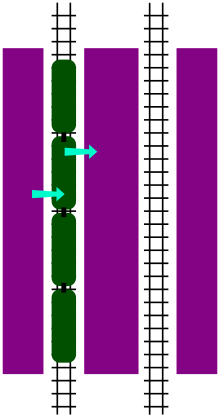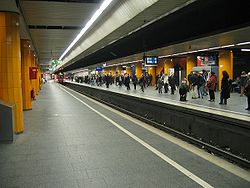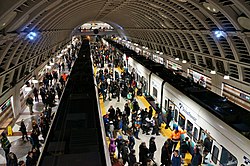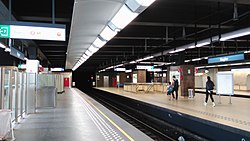Spanish solution
Spanish solution | |||||||||||||||||||||
|---|---|---|---|---|---|---|---|---|---|---|---|---|---|---|---|---|---|---|---|---|---|
Terminal station | |||||||||||||||||||||
| | |||||||||||||||||||||
Through station | |||||||||||||||||||||
| | |||||||||||||||||||||

In railway and rapid transit parlance, the Spanish solution is a station layout with two railway platforms, one on each side of the track,[1] which allows for separate platforms for boarding and alighting.
The "Spanish solution" is used in several stations of the Madrid Metro (e.g. Avenida de América) and Barcelona Metro (e.g. Sant Andreu).
Description
This platform arrangement allows the separation of passenger streams by using one platform only for boarding, and the other one only for alighting.[1] The separate designation of platforms for boarding and alighting has been proven effective at reducing dwell time at stations with high passenger numbers.[2]
The Spanish solution is most commonly applied at high-frequency underground metro stations. Stations are sometimes retrofitted to include a Spanish solution layout to expand the capacity of existing stations when there is no space to widen the existing platform, an issue that can occur in island platform configurations.
To encourage passengers to exit to the correct platform, arriving trains typically first open their doors facing the platform for alighting passengers, and then open the doors for boarding passengers after a slight delay.
Examples
An example of the Spanish Solution is the Karlsplatz (Stachus) station on the Munich S-Bahn, which has island platforms for boarding and side platforms for alighting.[citation needed]
Gallery
-
 Eastbound track at Marienplatz station, Munich S-Bahn
Eastbound track at Marienplatz station, Munich S-Bahn -
 Spanish solution on Line 6 at Charles de Gaulle - Étoile. Paris Metro
Spanish solution on Line 6 at Charles de Gaulle - Étoile. Paris Metro - Platforms of the Chabacano station on Line 8, Mexico City Metro.
-
 Boston's Park Street Under station in 1912. The same platform configuration is still in use.
Boston's Park Street Under station in 1912. The same platform configuration is still in use. -
 A temporary center platform at Pioneer Square station in Seattle used for transfers between trains
A temporary center platform at Pioneer Square station in Seattle used for transfers between trains -
 Olympic Park station in Sydney. All passengers alight on the middle island platform and board from the significantly wider outer platforms during major events.
Olympic Park station in Sydney. All passengers alight on the middle island platform and board from the significantly wider outer platforms during major events. -

See also
References
- ^ a b Olshausen, Hans-Gustav (9 March 2013). VDI-Lexikon Bauingenieurwesen [VDI-Lexikon civil engineering] (in German) (2nd ed.). Springer-Verlag. p. 63. ISBN 978-3-642-48098-0.
- ^ Fendrich, Lothar (25 January 2007). Handbuch Eisenbahninfrastruktur [Railway infrastructure handbook] (in German). Springer-Verlag. pp. 36, 37. ISBN 9783540317074.
External links
 Media related to Spanish solution at Wikimedia Commons
Media related to Spanish solution at Wikimedia Commons
- v
- t
- e
- Horseshoe curve
- Zig Zag / Switchback
- Spiral
 | This rapid transit-related article is a stub. You can help Wikipedia by expanding it. |
- v
- t
- e


















